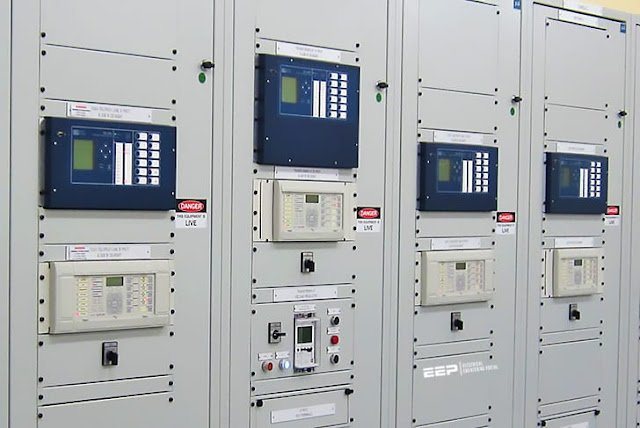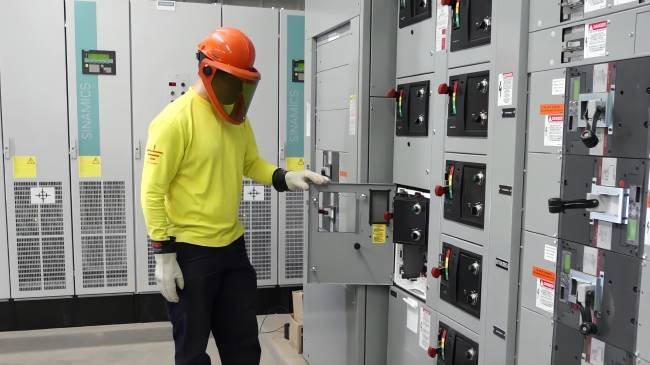When elements of the power system (such as generators or transmission lines) or the power system itself experience a fault that endangers the safe operation of the power system, relay protection can either alert the operating personnel with warning signals or directly send a tripping command to the controlled circuit breakers to terminate these events. This automated measure and equipment set is commonly referred to as a relay protection device.
This section provides a detailed introduction to the basic principles, requirements, tasks, classifications, common fault analysis, and handling of relay protection.
I. Basic Principles
A relay protection device must correctly distinguish whether the protected element is in a normal operating state or has experienced a fault, and whether the fault is within the protection zone or outside it. To achieve this, the device must be based on the characteristics of electrical quantities before and after a fault occurs in the power system.
After a fault in the power system, the main features of the power frequency electrical quantities change are:
- Current Increase: During a short circuit, the current in the electrical equipment and transmission lines between the fault point and the power source will increase significantly beyond the load current.
- Voltage Decrease: When a phase-to-phase or ground fault occurs, the phase-to-phase or phase voltage values at various points in the system will drop, and the closer to the fault point, the lower the voltage.
- Change in Phase Angle Between Current and Voltage: Under normal operation, the phase angle between current and voltage is the power factor angle of the load, generally about 20°. In the case of a three-phase short circuit, the phase angle is determined by the impedance angle of the line, generally 60°-85°. For reverse direction three-phase short circuits, the phase angle is 180° + (60°-85°).
- Change in Measured Impedance: Measured impedance is the ratio of voltage to current at the measurement point (protection installation location). Under normal operation, it is the load impedance. In metallic short circuits, it becomes the line impedance, significantly reducing after the fault, with an increased impedance angle.
For asymmetric short circuits, phase sequence components such as negative-sequence current and voltage components (in two-phase and single-phase ground faults) appear, which do not occur under normal operation. Utilizing these changes in electrical quantities during faults, various relay protection principles can be formulated.
In addition to protections that respond to power frequency quantities, there are protections that respond to non-power frequency quantities, such as gas protection.

II. Basic Requirements
To accomplish its tasks, a relay protection device must meet four basic technical requirements: selectivity, speed, sensitivity, and reliability. For relay protections that act on circuit breaker tripping, all four requirements must be met, while for those acting on signals or reflecting abnormal operating conditions, some requirements can be lowered.
- Selectivity: Selectivity ensures that when a fault occurs in the power system’s equipment or line, only the faulty equipment or line is isolated from the power system. If the protection or circuit breaker of the faulty equipment or line fails to operate, adjacent equipment or line protection should isolate the fault.
- Speed: Speed ensures that the relay protection device isolates faults as quickly as possible to minimize the duration of high-current, low-voltage operation, reduce equipment damage, and improve system stability in parallel operations.Faults that typically require rapid isolation include:
- Bus voltage at a power plant or important user dropping below effective value (typically 0.7 times the rated voltage).
- Internal faults in high-capacity generators, transformers, and motors.
- Medium and low-voltage line faults where the conductor section is too small to allow delayed isolation without overheating.
- Faults that pose safety hazards or cause significant interference to communication systems.
- Sensitivity: Sensitivity refers to the protection device’s ability to react to short-circuit faults or abnormal operating conditions within the protected range, measured by the sensitivity coefficient. A relay protection meeting sensitivity requirements should reliably act regardless of the fault point’s position, fault type, and whether there is transition resistance at the fault point.
- Maximum Operating Mode of the System: The short-circuit at the end of the protected line results in minimal system equivalent impedance, with maximum short-circuit current through the protection device.
- Minimum Operating Mode of the System: Under the same short-circuit fault conditions, the system equivalent impedance is maximum, with minimum short-circuit current through the protection device.
- Reliability: Reliability encompasses safety and dependability, the most fundamental requirements for relay protection.
- Safety: The protection should reliably avoid false operations when not required.
- Dependability: The protection should reliably operate when a fault within the specified protection range occurs.
These four basic requirements serve as the basis for designing, configuring, maintaining, analyzing, and evaluating relay protection. They are interrelated but often conflict, requiring a dialectical approach to unify them based on the power grid’s structure and user nature.

III. Basic Tasks
The basic tasks of power system relay protection are:
- Automatically, quickly, and selectively isolate faulty elements from the power system to prevent further damage to the faulty elements and ensure the remaining parts return to normal operation as quickly as possible.
- Reflect abnormal operating conditions of electrical elements and act on signals according to operation and maintenance conditions (e.g., whether there is frequent attendance), allowing operators to handle it promptly or enabling the device to adjust automatically, or isolating electrical equipment that could cause damage or accidents if it continues to operate. Quick action is not required here; instead, delays are set based on the harm to the power system and its components to avoid false operations caused by temporary fluctuations.
- Relay protection devices can also work with other automation devices in the power system to take preplanned measures when conditions allow, shortening outage times, quickly restoring power, and improving the power system’s reliability.
IV. Classification
Relay protection can be classified in the following four ways:
- By Protected Object: Including transmission line protection and main equipment protection (such as generators, transformers, busbars, reactors, capacitors).
- By Protection Function: Including short-circuit fault protection and abnormal operation protection. The former is subdivided into primary, backup, and auxiliary protection; the latter includes overload protection, loss-of-excitation protection, out-of-step protection, low-frequency protection, and open-phase operation protection.
- By Signal Quantity Used for Comparison and Computation: Including analog and digital protection. Analog protection covers electromechanical, rectifier, transistor, and integrated circuit (operational amplifier) devices reflecting continuous analog signals, while digital protection uses microprocessors and microcomputers reflecting discrete digital signals converted from sampled analog signals.
- By Action Principle: Including overcurrent protection, undervoltage protection, overvoltage protection, power direction protection, distance protection, differential protection, pilot protection, and gas protection.
V. Abnormalities
When relay protection exhibits abnormalities or defects, monitoring should be enhanced. For protection that may lead to false operations, exit the output panel and contact relay protection personnel for handling.
Immediate exit is required for the following abnormalities:
- Busbar Protection: When “busbar AC disconnection” or “busbar DC voltage loss” signals are issued; busbar unbalanced current is non-zero; during bus coupler switch operations without dedicated bypass busbars.
- Pilot Protection: When DC power is lost; regular channel test parameters do not meet requirements; device faults or channel abnormalities signal cannot be reset; during bypass bus switch operations.
- Distance Protection: When the used PT exits operation or three-phase voltage circuit is disconnected; abnormal magnetizing current; load current exceeds the allowed current for the protection segment.
- Microcomputer Protection: When the general alarm light is on and one of the four protections (pilot, distance, zero-sequence, comprehensive reclosure) alarm light is on, exit the corresponding protection; if both CPUs fail, exit all protections of the device; if the alarm plug-in lights are off and the power indicator light is off, indicating DC loss, exit the output panel, and re-enter after restoring DC power; if the general alarm and call lights are on and the printout shows CPU × ERR signal, indicating communication circuit abnormalities between the protection and interface CPU, exit the CPU inspection switch for handling. If the signal cannot be reset, exit the protection output panel and disconnect the inspection switch for handling.
- Gas Protection: During oil filling, oil filtering, or silica gel replacement for transformers; when putting the oil pump or cooler (radiator) back into operation after oil draining maintenance; when opening the breather system vent or drain plug, or cleaning the desiccator; during work on the on-load tap changer oil circuit.
VI. Common Fault Analysis in Relay Protection
- Current Transformer Saturation Fault: Current transformer saturation significantly affects relay protection. As terminal loads increase, short-circuit currents can become extremely high. When a short circuit occurs near the terminal equipment area, the current can exceed 100 times the rated current of the current transformer. In such cases, the accuracy of the current transformer decreases as the short-circuit current increases, potentially preventing action in instantaneous overcurrent protection. During line short circuits, transformer saturation results in reduced or zero secondary current, causing delayed overcurrent protection to fail. If outgoing line overcurrent protection fails, it can lead to disconnection of the entire distribution system.
- Inappropriate Selection of Switch Protection Equipment: Proper selection of switch protection equipment is crucial. High-load areas often use switch stations, supplying power through transformer stations. In non-automated switch stations, load switches or relay combinations should be used for protection.
VII. Handling Methods and Measures for Relay Protection Faults
- Common Handling Methods for Relay Protection Faults:
- Replacement Method: Replace suspected faulty components with good ones to quickly narrow down fault locations.
- Reference Method: Compare technical parameters of normal and abnormal equipment to find faults. This method is useful for checking wiring errors and discrepancies during calibration.
- Short Circuit Method: Short-circuit a segment or part of the circuit to determine fault locations. This method is useful for handling issues like electromagnetic lock failures, current circuit open circuits, and switch contact issues.
- Measures to Ensure Normal Operation of Relay Protection:
- Personnel Allocation: Reasonable personnel allocation ensures smooth scheduling and cooperation, guaranteeing normal power operation.
- Improving Regulations: Establish and improve management regulations for relay protection operations, maintenance, accident analysis, periodic calibration, and defect handling. Use computer management for tracking and assessments, with strict accountability and rewards/punishments.
- Status Monitoring: Implement status monitoring for secondary equipment. For comprehensive automated substations, relay protection status monitoring is easier to achieve.
This comprehensive guide aims to provide in-depth knowledge about relay protection, covering principles, requirements, tasks, classification, common faults, and handling methods to ensure the safe and efficient operation of power systems.



